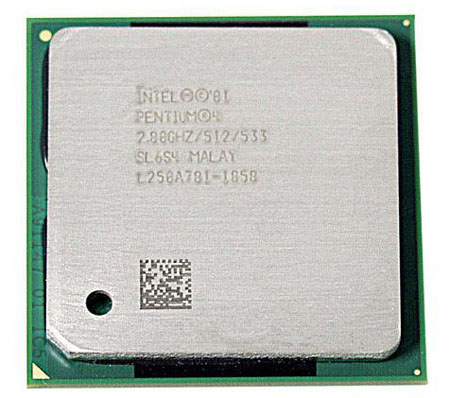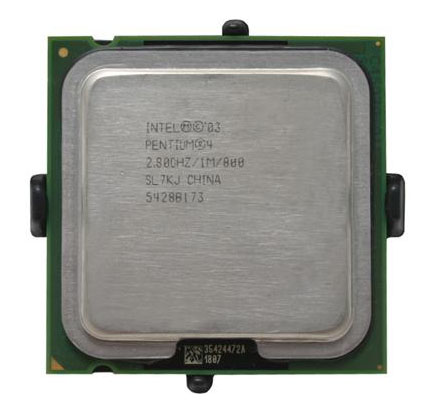Processor Obfuscation and You: An Update on AMD and Intel CPUs
by Kristopher Kubicki & Jarred Walton on May 17, 2005 12:00 PM EST- Posted in
- CPUs
Intel Processors
With AMD out of the way, we'll move on to the code names and features of all the currently shipping Intel processors. We only have two platforms this time - not counting the server and mobile options. The good news is that there isn't quite as much overlap in the Intel world. Sure, we have numerous chips running at similar clock speeds, but with a few exceptions, each model number explicitly defines one set of features. Where AMD has four different Athlon 64 3400+ chips (including the obscure 2.2 GHz 512K 939 chip that is limited to an 800 MHz HyperTransport link), the Intel Pentium 540J is always a 3.2 GHz Prescott core for socket 775. Let's take a look at the shipping cores.| Intel Processors | ||||
| Core Name | CPU Name | L2 Cache | Process | Notes |
| Socket 478 | ||||
| Northwood | Celeron | 128K | 130nm | No SSE3 |
| Northwood | Pentium 4 | 512K | 130nm | No SSE3 |
| Prescott | Celeron D | 256K | 90nm | |
| Prescott | Pentium 4 | 1024K | 90nm | |
| Socket (LGA) 775 | ||||
| Prescott | Celeron D | 256K | 90nm | Partial EM64T |
| Prescott | Pentium 4 5xx | 1024K | 90nm | Partial EM64T |
| Irwindale | Pentium 4 6xx | 2048K | 90nm | |
| Cedar Mill | Pentium? | 2048K | 65nm | |
| Smithfield | Pentium D | 2 x 1024K | 90nm | Dual Core |
| Presler | Pentium D? | 2 x 2048K | 65nm | Dual Core |
Socket 478

For 2.8 GHz and above, we'd say look to overclocking first (if you haven't already), and if you're still unsatisfied, you'll probably want to ditch the platform rather than investing more money. Those running anything less than a 2.6 GHz chip might consider purchasing one of the faster chips before they entirely disappear, but you're basically delaying the inevitable. Unlike AMD, however, socket 775 doesn't offer a whole lot in the way of improved performance. DDR2 and PCI Express won't be available without switching to socket 775, but they're not truly necessary. We wouldn't spend a whole lot of money on a new AGP card, but if you already have something reasonably powerful, you're probably best off waiting a bit longer to upgrade from anything sporting an 865PE or 875P chipset (or else jumping ship and purchasing an AMD system).
Socket 775

The next Intel core is Smithfield, which received its official name with the recently released Pentium D processors - although really, we should call them "the recently announced" Pentium D processors, as they are not yet available for purchase at any retailers. (That should hopefully change in the next month.) Smithfield processors will use 8xx model numbers to differentiate them from their single core relatives. Like the 6xx series, the 8xx processors all feature support for EIST and EM64T, but they add a second core. Multitasking in particular stands to benefit a lot from the addition of a second core, but for running a single-threaded application (without a bunch of other processes), a higher clocked 5xx or 6xx chip is still going to be faster. The Extreme Edition also has HyperThreading enabled, allowing the execution of four simultaneous threads. Unfortunately, HyperThreading is not always beneficial, as there are cases where the Pentium Extreme Edition 840 is outperformed by the Pentium D 840.
There are drawbacks for Pentium D: heat output and power consumption. The power draw of a Pentium D system scales rapidly with increased clock speeds. In order to combat this, Intel has been forced to reduce the shipping clock speeds of their dual core chips. This means that while 3.6 and 3.8 GHz parts are available for the 5xx and 6xx lines, the fastest 8xx chip is currently 3.2 GHz. Sure, the relative power draw of Pentium D may only be 15% higher than Pentium 4, but when you're talking about 100+ Watts, removing an additional 15% can become difficult. You could also say that the lower clock speeds tie into the more affordable prices that Intel is presenting. Where AMD is essentially releasing dual core variants of their 3500+ and higher processors, Intel is only releasing 2.8 to 3.2 GHz parts. If AMD had 1.8 and 2.0 GHz dual core parts, the prices might be quite a bit lower.
Even with these drawbacks, the Pentium D is still an attractive part for many people. The biggest problem is that the Pentium D is not yet available for purchase, and while it uses the same socket (LGA 775), you need a motherboard with one of the new 945/955 Intel chipsets. (The NVIDIA nForce 4 SLI chipset will also work, provided that the motherboard manufacturer has designed their board properly.) If you're serious about purchasing a new computer and you're set on an Intel system, we would strongly recommend waiting for the new motherboards and processors to become available.










55 Comments
View All Comments
nserra - Wednesday, May 18, 2005 - link
I agree that the amd scheme is confusing in the point of detecting which model really is.One problem that was easily solved by adding two numbers or a letter, something like this:
Model 3200+:
>3210+ - socket 754,512Kb cache
>3251+ - socket 939,512Kb cache
>3225+ - socket 754,256Kb cache (fiction)
Or just 3210, 3220, 3230, ... or like the GPUs 3250 and 3200.
And I don’t think that Intel model scheme is better I can also be buying something that I don’t want.
muffin - Wednesday, May 18, 2005 - link
Clawhammers can be CG. They can also overclock well, better than a Newcastle can...No mention of Newark cores? Seem to overclock very well.
nserra - Wednesday, May 18, 2005 - link
Also here:http://www.amdcompare.com/us-en/desktop/default.as...
is a very good database.
nserra - Wednesday, May 18, 2005 - link
There is something you could add to the sempron part of the article.Only sempron 3000+ and up have cool&quite. The others don’t.
I don’t know also if all Amd64 processor are cool&quite(older ones).
JarredWalton - Wednesday, May 18, 2005 - link
29 - I don't know a whole lot about Turion, so if I'm completely wrong feel free to let me know. Indications so far (that I've heard) are that it will basically be a renamed Athlon 64 for socket 754, only with improved power characteristics and better sleep states. When you see the power usage reduction of the Winchester vs. the Newcastle on 939, it's safe to say that 90nm SOI parts for 754 would be much better as "Mobile" chips. Hopefully there's more to it than that, though.JarredWalton - Wednesday, May 18, 2005 - link
I'm not entirely sure I believe the memory controller makes the new San Diego and Venice "more compatible", although I suppose it could. Memory compatibility is usually more of a factor of BIOS and motherboard support. Anyway, we did (briefly - on page 3) mention the improvements to the caching algorithms/controller on the 90nm chips. I sort of lump the caching and memory controller into one group, but you are right, changes were made (we're not sure what) and the new cores are overall better choices.As for the CG Hammer cores, I'll just have to take your word on that. Kris is the stepping/SKU man. I just provided the rambling commentary. :)
Capodast - Wednesday, May 18, 2005 - link
A question about Turion.As mentioned in a previous article here "The Turion 64 is based on the latest revision E4 of the K8 core, meaning that it supports SSE3 instructions as well as lower power states ... The Turion 64 will be available in both 1MB L2 and 512KB L2 cache models, but both models will only support a 64-bit (single channel) DDR400 memory controller".
Does anyone know if it will be generally available as a socket 754 option as with the Athlon XP-M for socket A?
Heidfirst - Wednesday, May 18, 2005 - link
You don't appear to have mentioned that the Venice & San Diego have an improved memory controller allowing more RAM to run at 400. To many people that is the more important reason to get 1 rather than SSE3PS I've got a "CG" stepping Clawhammer too ...
flatblastard - Wednesday, May 18, 2005 - link
I don't blame you for what you said, i just thought it was a little out of place on the page.I mean after all, you were just being honest I guess I'm just being too picky, please forgive me. I'm Looking forward to the next buyers guide...JarredWalton - Tuesday, May 17, 2005 - link
It wasn't meant to be biased, and you can blame me for that. I'm just saying that *if* you've got an 865/875 system and you're thinking of upgrading, I'd either wait for Pentium D or go for socket 939. Anyway, I'll cover that more in an upcoming Buyer's Guide. Actually, the Guide is all done and submitted, so next article slot that opens up should get the Guide in it. With E3 going on this week, though, it might be Friday before the BG gets posted.I'm not trying to be biased here, but it's *really* hard to recommend a current socket 775 system. Give me 945/955 (of nF4SLI) and Pentium D and there are many cases to be made for Intel. 915/925 and Prescott is just trailing.
Worth noting (although I wasn't with AnandTech at the time) is that I said the same thing at the end of the Athlon XP era. At the lower prices, Athlon XP was still really attractive, but only a completely biased person would have recommended Athlon XP 3200+ over a similarly priced Pentium 3.0/3.2C.